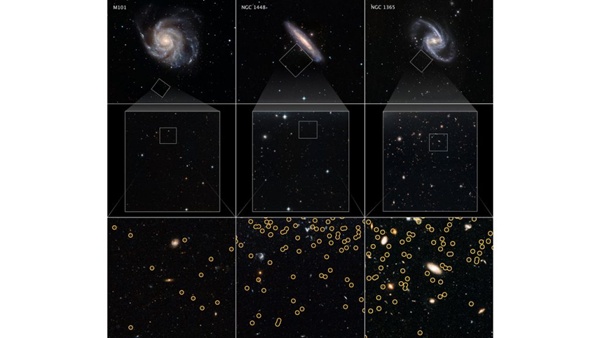Constant confusion: New studies deepen mystery of universe’s expansion – Astronomy Magazine
Astronomers used the Hubble Space Telescope to compare the brightness of distant red giant stars to the brightness of nearby ones. Because these ancient stars have the same brightness, scientists can use their light as a “standard candle” to find out how far away their host galaxy is from Earth. That result can then by compared to the galaxies apparent recession rate, offering up a measure of how fast our universe is expanding. The red giants, found in their galaxy’s halos, are shown here in yellow circles.
NASA, ESA, W. Freedman (University of Chicago), ESO, and the Digitized Sky Survey
A New Measure
Freedman and her team used a new method for determining the Hubble constant. They used the Hubble Space Telescope and other instruments to measure the brightnesses of the brightest red giant stars in the outskirts of other galaxies. These ancient suns are relatively simple objects with a nearly uniform and well-known luminosity, so astronomers can convert precise brightness measurements into distances.
This method differs from previous efforts, including Freedman’s own Hubble Space Telescope Key Project of two decades ago. Instead of studying red giants, other teams have tracked our expanding universe using Cepheids, which are young stars that periodically vary in brightness. Recent measurements using Cepheids have found the Hubble constant to be around 73. And in April, the SH0ES team, led by Nobel laureate Adam Riess of the Space Telescope Science Institute and Johns Hopkins University, measured a rate of 74.
Astronomers would have expected the red giant and Cepheid methods to give the same answer. But they’re off by just enough to be cosmologically significant. The reason for this discrepancy, says Riess, is that his group and Freedman’s group used different methods to account for the dimming effects of dust.
Riess says that if Freedman’s team had used the same method, their Hubble constant result would nearly match that of SH0ES. “This result actually gives me more confidence in our result,” he says.
In stark contrast, the H0LICOW team uses a totally independent strategy that relies on geometry rather than observing individual stars in other galaxies. H0LICOW monitors distant quasars — active supermassive black holes at the hearts of large galaxies — that have been gravitationally lensed by foreground galaxies. The space-time warping effect of these massive galaxies create lenses that split light, creating multiple images of the same quasar. As a result, the light from each image takes a different path to reach Earth. By watching the different quasar images flicker in brightness over months and years, the H0LICOW astronomers measured a Hubble constant of 73.3.
“Our results agree very well with that of SH0ES,” notes Suyu.
The fact that H0LICOW and SH0ES derive the same expansion rate (within their margins of error) despite using radically different methods gives a great deal of confidence that the Hubble constant is somewhere around 73 to 74. If the red giant method can somehow be brought into line with these other methods, astronomers will probably consider the Hubble constant to be a solved problem.






